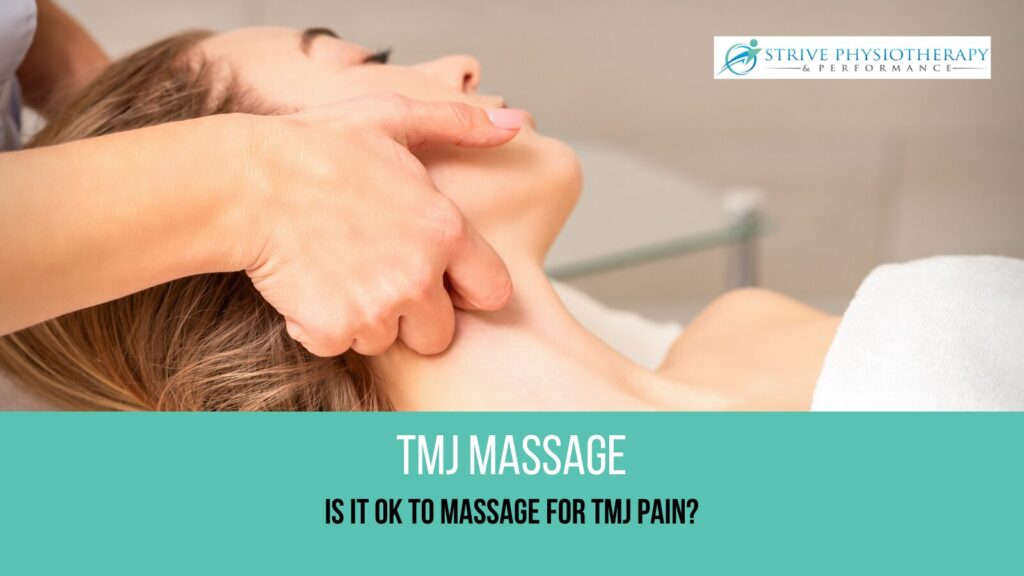
TMJ stands for ‘temporomandibular joint’. The temporal bone is part of your skull, the mandible is the lower half of your jaw. Together, they form a joint. If you want to feel your TMJ moving, place your fingers about 1 finger width in front of your ear openings, and open/close your mouth.
Your TMJ joints also have a disc between the two bones. Oftentimes, it is this disc that causes your TMJ troubles. But can you massage your TMJ to help relieve some of the pain? Let’s find out!
Is It OK To Massage TMJ?
Yes, it is okay to massage the temporomandibular joint (TMJ). Massaging the TMJ can help with symptoms of pain and stiffness. It’s a good idea to start with light pressure and then gradually increase it as tolerated. Too much pressure can aggravate symptoms, especially if you’re not used to massage in that area.
Massage therapy should be applied to the muscles around the TMJ first before directly massaging the TMJ itself. This will help you determine how irritable the TMJ is. In some cases, the TMJ may be too sensitive to massage directly, and the treatment will need to be focused on the surrounding muscles. Massage can be applied to the jaw muscles, facial muscles, and surrounding muscles (e.g. neck and shoulder muscles).
What Kind of Massage Is Good for TMJ?
Swedish massage is a good first step to massaging the TMJ. It involves a lighter pressure and is primarily used for relaxation and releasing tension. If Swedish massage is tolerated well, then deep tissue massage may also be helpful. Deep tissue massage involves significantly more pressure than Swedish massage.
While this can be helpful, some individuals who have more pain may find it aggravates their symptoms. As such, it’s a good idea to start with lighter pressure and then increase it if tolerated well. Both massages targeting the jaw muscles and massages targeting the surrounding muscles can be good for TMJ pain relief.
Where Do You Massage for TMJ Pain?
Massage can be applied to muscles that directly control the TMJ and muscles in the surrounding areas to help manage pain and stiffness. The muscles that directly control the TMJ function to open and close the jaw. The lateral pterygoid and digastric muscles function to open the jaw, while the masseter, temporalis, and medial pterygoid muscles function to close the jaw.
The masseter is located along the side of the jaw and the temporalis is located on the side of the head. Both can be felt when you clench or squeeze your jaw closed. The digastric muscle lies underneath your jaw. These muscles can be massaged by applying pressure directly to the skin’s surface.
Since the lateral and medial pterygoid muscles are located deep within the jaw and underneath the masseter, they are often massaged intra-orally. A therapist may use gloves and reach within your mouth to apply intra-oral massage to both of the pterygoid muscles.
Does Indian Head Massage Help TMJ?
Indian head massage involves massaging the head and surrounding muscles to help relieve tension and promote relaxation. Similar to other forms of massage, it can be helpful for TMJ pain and stiffness. Indian head massage will target some of the muscles that control the TMJ, as well as surrounding muscles.
TMJ pain and stiffness can be related to multiple different factors, including stress. Indian head massage can help by relieving feelings of stress and tension throughout the head.
How Do I Relax My Jaw Muscles?
It can be difficult to allow your jaw muscles to completely relax when they are tense. Becoming aware of your posture and positioning can help release tension. To start, try resting your tongue at the top of your mouth just behind your teeth. This allows your tongue muscles to rest and moves your jaw to a neutral position.
Next, sit up as tall as you can comfortably. One way to visualize this is to pretend there is a string attached to the top of your head and it’s pulling you straight up. Then, allow your shoulders to relax down (make sure you’re not holding them up towards your ears). Finally, take a deep breath in through your nose and then slowly out through your mouth.
Repeat this process throughout the day as often as you can to allow your body to relax and release some of the tension. Research shows that regular bouts of deep breathing can help with managing stress and aiding relaxation.
Heat and massage can also help relieve muscle tension. Try a warm compress over the jaw muscles for 5 to 10 minutes to start. Make sure the compress is not too warm and add a cloth cover before applying it to your skin to avoid burning yourself.
Final Words
Is your TMJ making eating, talking, or sleeping difficult? Call us at 519-895-2020, or use our online booking tool at www.strivept.ca to book an appointment with one of our knowledgeable physiotherapists or registered massage therapists and get your recovery started today.
Our multidisciplinary team can also help you with many common conditions including but not limited to chronic pain, sports injuries and impaired range of motion.